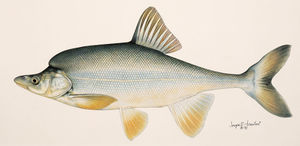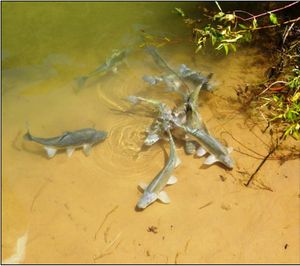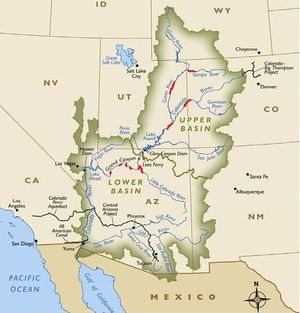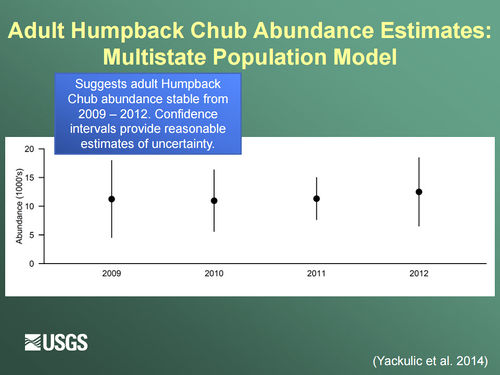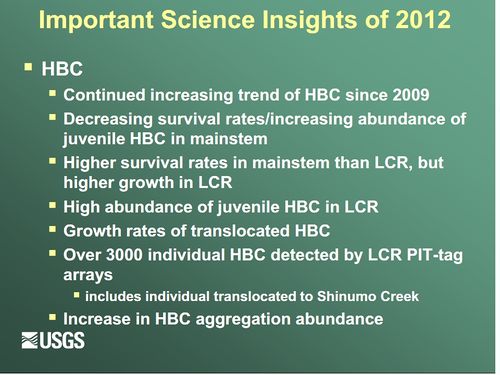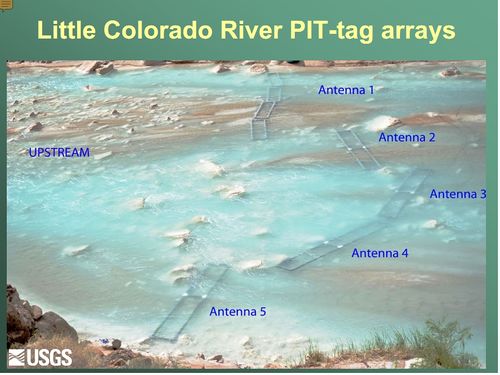Difference between revisions of "Humpback Chub Page"
Cellsworth (Talk | contribs) |
Cellsworth (Talk | contribs) |
||
| Line 14: | Line 14: | ||
<td width=40% valign=bottom align=left style='width:2.05in;padding:0in 5.4pt 0in 5.4pt'> | <td width=40% valign=bottom align=left style='width:2.05in;padding:0in 5.4pt 0in 5.4pt'> | ||
<p class=MsoNormal> | <p class=MsoNormal> | ||
| − | [[Image:Humpback-large- PIC.jpg|thumb|left| | + | [[Image:Humpback-large- PIC.jpg|thumb|left|300px]] |
| − | [[File:HBC-Kurt- PIC.jpg| | + | [[File:HBC-Kurt- PIC.jpg|300px]] |
| − | [[File:HBC distribution USFWS.jpg | | + | [[File:HBC distribution USFWS.jpg |300px]] |
</p> | </p> | ||
</td> | </td> | ||
| Line 28: | Line 28: | ||
|style="width:60%; font-size:120%;"| | |style="width:60%; font-size:120%;"| | ||
'''Description'''<br> | '''Description'''<br> | ||
| − | + | The humpback chub (Gila cypha) is an endangered, native fish of the Colorado River that evolved around 3-5 million years ago. The pronounced hump behind its head gives this fish a striking, unusual appearance. It has an olive-colored back, silver sides, a white belly, small eyes and a long snout that overhangs its jaw. Like the Colorado pikeminnow and bonytail, the humpback chub is a member of the minnow family. | |
| − | + | ||
The humpback chub is a relatively small fish by most standards – its maximum size is about 20 inches and 2.5 pounds. By minnow standards it is a big fish, though not like the giant of all minnows – the Colorado pikeminnow. Humpback chub can survive more than 30 years in the wild. It can spawn as young as 2 to 3 years of age during its March through July spawning season. | The humpback chub is a relatively small fish by most standards – its maximum size is about 20 inches and 2.5 pounds. By minnow standards it is a big fish, though not like the giant of all minnows – the Colorado pikeminnow. Humpback chub can survive more than 30 years in the wild. It can spawn as young as 2 to 3 years of age during its March through July spawning season. | ||
| Line 35: | Line 34: | ||
Although the humpback chub does not have the swimming speed or strength of the Colorado pikeminnow, its body is uniquely formed to help it survive in its whitewater habitat. The hump that gives this fish its name acts as a stabilizer and a hydrodynamic foil that helps it maintain position. The humpback chub uses its large fins to “glide” through slow-moving areas, feeding on insects that become trapped in water pockets. | Although the humpback chub does not have the swimming speed or strength of the Colorado pikeminnow, its body is uniquely formed to help it survive in its whitewater habitat. The hump that gives this fish its name acts as a stabilizer and a hydrodynamic foil that helps it maintain position. The humpback chub uses its large fins to “glide” through slow-moving areas, feeding on insects that become trapped in water pockets. | ||
| − | Status and distribution | + | |
| − | + | '''Status and distribution'''<br> | |
| − | + | The humpback chub was listed as endangered by U.S. Fish and Wildlife Service in 1967 and given full protection under the Endangered Species Act of 1973. Historically, humpback chub inhabited the swift and turbulent waters in canyons of the Colorado River and three of its tributaries: the Green and Yampa rivers in Colorado and Utah, and the Little Colorado River in Arizona. The species was first discovered in 1946. Before that time, few people ventured into these treacherous regions – including fishery biologists. | |
| − | + | ||
| − | Historically, humpback chub inhabited the swift and turbulent waters in canyons of the Colorado River and three of its tributaries: the Green and Yampa rivers in Colorado and Utah, and the Little Colorado River in Arizona. The species was first discovered in 1946. Before that time, few people ventured into these treacherous regions – including fishery biologists. | + | |
Today, five self-sustaining populations of humpback chub occur in the Upper Colorado River Basin. Two to three thousand adults can occur in the Black Rocks and Westwater Canyon core population in the Colorado River near the Colorado/Utah border. Several hundred to more than 1,000 adults may occur in the Desolation/Gray Canyon core population in the Green River. Populations in Yampa and Cataract canyons are small, each consisting of up to a few hundred adults. | Today, five self-sustaining populations of humpback chub occur in the Upper Colorado River Basin. Two to three thousand adults can occur in the Black Rocks and Westwater Canyon core population in the Colorado River near the Colorado/Utah border. Several hundred to more than 1,000 adults may occur in the Desolation/Gray Canyon core population in the Green River. Populations in Yampa and Cataract canyons are small, each consisting of up to a few hundred adults. | ||
The largest known population of humpback chub is in the Lower Colorado River (LCR) Basin in the Grand Canyon -- primarily in the LCR and its confluence with the main stem of the Little Colorado River. In 2009, the U.S. Geological Survey announced that this population increased by about 50 percent from 2001 to 2008. The agency estimates that the number of adults is between 6,000 and 10,000, with the most likely number being 7,650 individuals. | The largest known population of humpback chub is in the Lower Colorado River (LCR) Basin in the Grand Canyon -- primarily in the LCR and its confluence with the main stem of the Little Colorado River. In 2009, the U.S. Geological Survey announced that this population increased by about 50 percent from 2001 to 2008. The agency estimates that the number of adults is between 6,000 and 10,000, with the most likely number being 7,650 individuals. | ||
| − | |||
| − | |||
|}<!-- | |}<!-- | ||
Revision as of 10:10, 2 June 2016
|
Description The humpback chub is a relatively small fish by most standards – its maximum size is about 20 inches and 2.5 pounds. By minnow standards it is a big fish, though not like the giant of all minnows – the Colorado pikeminnow. Humpback chub can survive more than 30 years in the wild. It can spawn as young as 2 to 3 years of age during its March through July spawning season. Although the humpback chub does not have the swimming speed or strength of the Colorado pikeminnow, its body is uniquely formed to help it survive in its whitewater habitat. The hump that gives this fish its name acts as a stabilizer and a hydrodynamic foil that helps it maintain position. The humpback chub uses its large fins to “glide” through slow-moving areas, feeding on insects that become trapped in water pockets.
Today, five self-sustaining populations of humpback chub occur in the Upper Colorado River Basin. Two to three thousand adults can occur in the Black Rocks and Westwater Canyon core population in the Colorado River near the Colorado/Utah border. Several hundred to more than 1,000 adults may occur in the Desolation/Gray Canyon core population in the Green River. Populations in Yampa and Cataract canyons are small, each consisting of up to a few hundred adults. The largest known population of humpback chub is in the Lower Colorado River (LCR) Basin in the Grand Canyon -- primarily in the LCR and its confluence with the main stem of the Little Colorado River. In 2009, the U.S. Geological Survey announced that this population increased by about 50 percent from 2001 to 2008. The agency estimates that the number of adults is between 6,000 and 10,000, with the most likely number being 7,650 individuals. |
| Fish Species of the Colorado River in Lower Glen Canyon and Grand Canyon (See Fish Table) |
TBD (TBD) |
TBD (TBD) |
|---|
